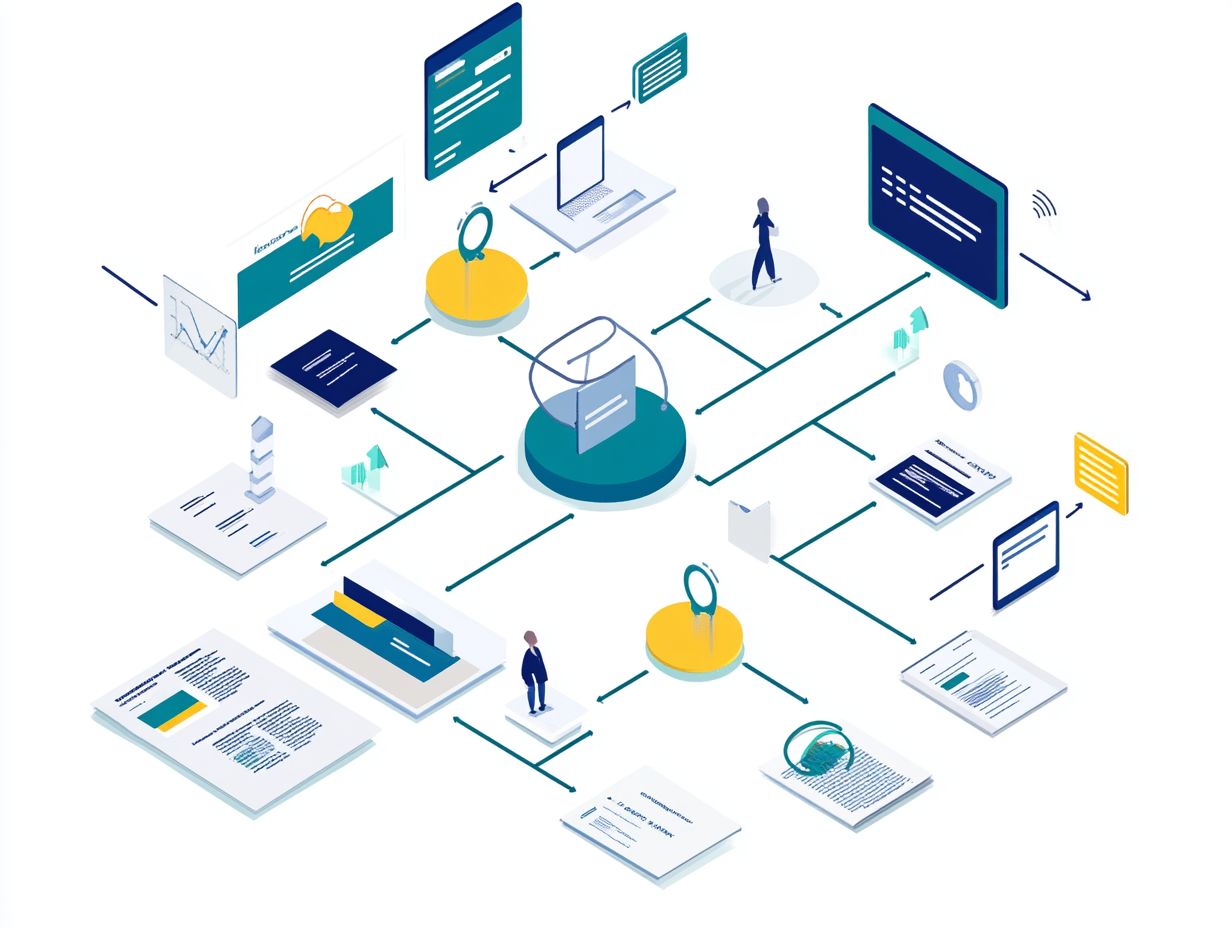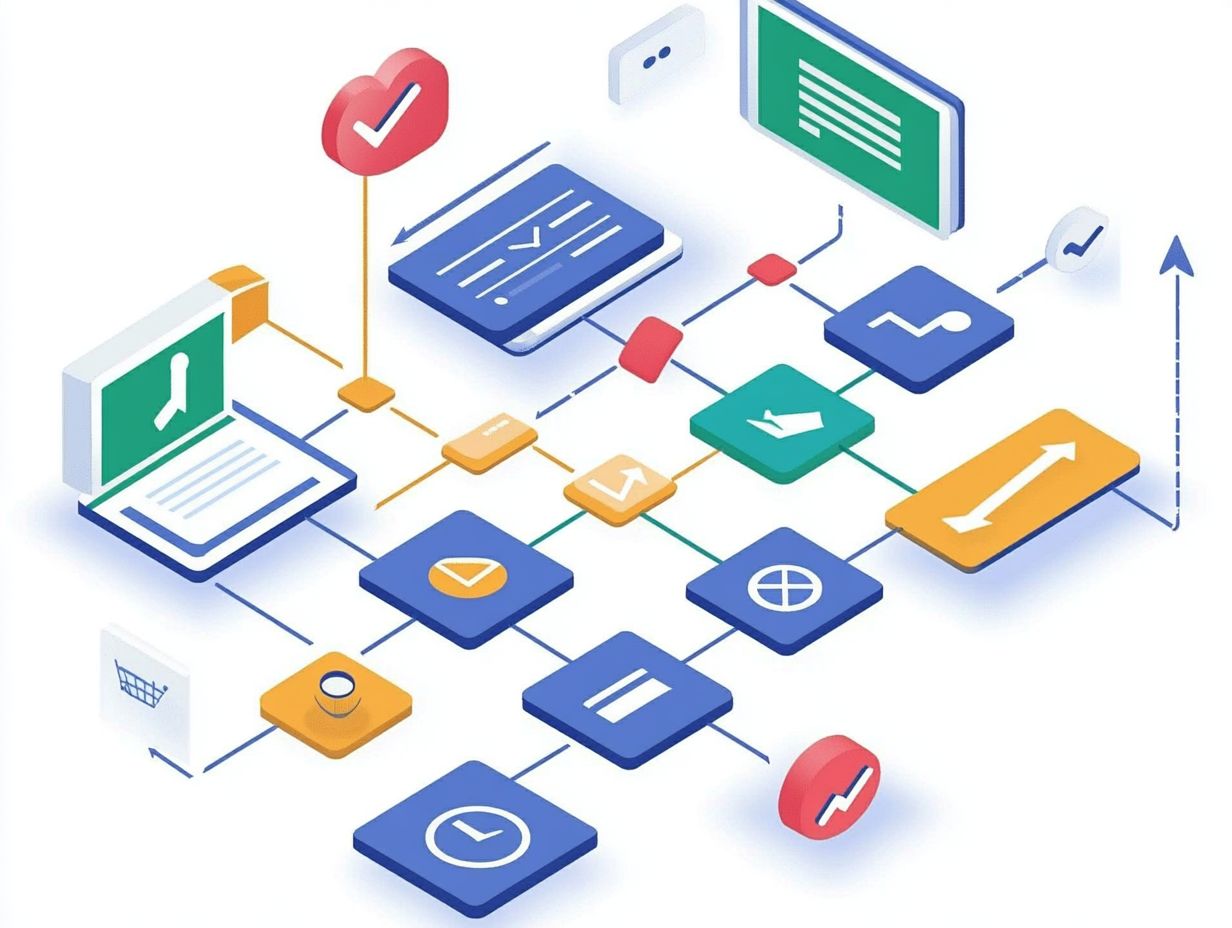What is a CRM Workflow?
In today’s fast-paced business landscape, understanding CRM workflows is essential for your success. This article explains the definition and purpose of CRM workflows, showcasing how they streamline processes and elevate efficiency.
You ll uncover many benefits of implementing these workflows, from enhancing productivity to automating tedious tasks. We ll walk you through the key components of a CRM workflow and outline a step-by-step process for creating and managing one effectively.
You will discover best practices for seamless integration and gain insights into overcoming common challenges. Jump in now and unlock the full potential of CRM workflows for your business!
Contents
Key Takeaways:

CRM workflows improve efficiency and productivity by automating and customizing business processes, reducing manual tasks and human error.
Integrating CRM workflows into business processes can optimize performance and provide a streamlined customer experience.
To create and manage a successful CRM workflow, it is important to understand its key components and follow a step-by-step process while also incorporating best practices and tips.
Understanding CRM Workflows
Understanding CRM workflows is crucial for elevating customer relationship management within your organization. A well-defined CRM workflow streamlines the sales process, enhances account management, and improves user experience, resulting in heightened customer engagement and satisfaction.
This structured approach gives your sales teams the power to manage their tasks with precision, enabling effective lead scoring, tracking of customer journeys, and automation of repetitive tasks.
By seamlessly integrating data management and leveraging cutting-edge technology, you can ensure that your workflow aligns with both sales operations and overarching business processes, ultimately driving productivity and efficiency to new heights.
Definition and Purpose
A CRM workflow is designed to streamline your Customer Relationship Management by automating various business processes. These workflows enable you to manage leads effectively, optimize your sales cycles, and enhance customer satisfaction through personalized interactions.
Every component of a CRM workflow plays a vital role in creating a seamless experience, starting with lead capture and nurturing through targeted marketing campaigns. This process tracks interactions and analyzes customer behavior, enabling you to execute timely follow-ups and tailored communication.
As these workflows unfold, they empower your sales teams to prioritize prospects effectively, fostering stronger relationships built on data-driven insights. By managing tasks and reminders, a well-structured CRM workflow allows you to concentrate on building rapport with clients, significantly enhancing the overall customer experience and driving long-term loyalty.
Benefits of Implementing a CRM Workflow
Implementing a CRM workflow presents a wealth of advantages, particularly in enhancing efficiency and productivity within your sales teams.
By seamlessly integrating automated actions into your daily operations, you can streamline lead management and elevate customer engagement.
This approach accelerates your sales process and boosts conversion rates, as your sales reps gain access to performance analytics that empower them to make informed decisions.
Efficiency and Productivity
The efficiency and productivity gained from a well-implemented CRM workflow can transform your sales operations. By automating routine tasks and optimizing task management, you’ll focus more on building customer relationships and closing deals resulting in improved conversion rates.
This shift enables you to allocate your time more effectively, significantly reducing the chances of missed follow-ups or overlooked leads. For example, automated reminders and streamlined lead tracking within a CRM system can enhance your task management, ensuring that no opportunity slips through the cracks.
As a result, not only will you become more organized, but you’ll also experience enhanced collaboration among your team members. This synergy can lead to higher sales performance, as your team is better equipped to share insights and strategies, creating a more cohesive approach to nurturing leads and hitting those sales targets.
Start enhancing your customer relationships today with effective CRM workflows!
Essential Parts of a CRM Workflow

The key parts of a CRM workflow include automation, customization, and effective lead scoring. Each plays a vital role in creating a smooth sales pipeline.
Automation tools enhance task management. They allow your sales team to focus on meaningful client interactions instead of repetitive tasks.
With strong customization options, you can tailor your workflows to meet your specific needs. This optimizes your CRM system for maximum efficiency.
Automation and Customization
Automation and customization elevate your CRM workflows. They make them responsive to your unique business needs.
This empowers you to automate repetitive tasks and tailor workflows, enhancing both sales operations and customer interactions.
Embracing automation tools streamlines processes like lead scoring and follow-up communications. Imagine automating email alerts for significant client interactions, customizing reminders based on deal size or client history.
Platforms like Salesforce or HubSpot let you create custom dashboards. This allows you to visualize the key metrics that matter in your industry.
This blend of automation and personalization boosts efficiency and enriches customer relationships. Every interaction feels relevant and timely.
Creating and Managing a CRM Workflow
Creating and managing a CRM workflow requires a careful, step-by-step method. It ensures effective lead assignment and streamlines sales cycles.
Each stage should enhance lifecycle management. This helps sales representatives track user interactions and manage prospects easily.
This structured method empowers your sales team to focus on their goals. It also boosts customer satisfaction through prompt follow-ups and efficient support ticket handling.
Step-by-Step Process
The process for creating a CRM workflow begins with defining your objectives. Understand the user experience deeply.
Then, map out your sales pipeline, establish lead assignment criteria, and set up automation tools. This streamlines your operations.
By clearly outlining your objectives, you ensure that every action aligns with your goals. This boosts efficiency.
Understanding user experience is crucial. A well-structured workflow must cater to the needs of your sales team.
While mapping out your pipeline, identify key stages and potential bottlenecks. Good lead assignment criteria improve lead quality and speed up their movement through the funnel.
Incorporating effective automation tools reduces manual tasks. This lets your team focus on building relationships and enhances the sales process.
Integrating CRM Workflows into Business Processes
Integrating CRM workflows into your business processes enhances efficiency in your sales operations and customer support.
Using best practices in workflow automation helps you streamline your processes. This fosters better digital adoption across your teams.
This integration simplifies tasks for your sales representatives. It also keeps customer engagement a priority.
Ultimately, this leads to higher customer satisfaction and retention rates. Your organization will be positioned for long-term success.
Introduction
In today’s fast-paced business environment, optimizing your Customer Relationship Management (CRM) workflows is essential. Here are some best practices and tips to help you achieve maximum efficiency and enhance customer engagement.
Best Practices and Tips

Implementing best practices is crucial for maximizing the effectiveness of your CRM workflows. Focus on workflow automation to save time.
Using technology can streamline data management and ensure that each customer receives timely follow-ups tailored to their preferences. Understanding customer journeys and mapping touchpoints significantly enhances engagement.
The insights gained from analytics allow you to refine your strategies. Using tools like email marketing automation and chatbots creates a seamless experience.
These tools enable quick responses while allowing your team to concentrate on building meaningful relationships. Providing training for your team members boosts overall efficiency and fosters a culture of responsiveness.
Common Challenges and Solutions
Common challenges in implementing and maintaining CRM workflows can greatly impact your sales team’s efficiency. Recognizing these obstacles opens the door to effective solutions.
Resistance to change, inadequate training, and insufficient feedback collection can impede the optimization of your processes. By addressing these challenges with targeted solutions, you can enhance collaboration and improve task management.
This ultimately elevates customer engagement and satisfaction rates.
Overcoming Roadblocks
Make process optimization a priority to transform your CRM experience. Overcoming roadblocks demands a strategic mindset paired with effective solutions tailored to your specific challenges.
Identifying common challenges, such as data silos and poor communication, is essential. These obstacles can disrupt a seamless workflow and lead to frustration among your team members.
To tackle these issues, cultivate a culture of open dialogue. Ensure every team member is equipped with the right tools and knowledge to significantly enhance collaboration.
Regularly reviewing and refining your processes allows you to adapt to changing needs and boost operational efficiency. Integrating automation and using analytics can further streamline your efforts.
This frees your team to focus on nurturing strong customer relationships instead of getting buried under repetitive tasks.
Frequently Asked Questions
Here are some frequently asked questions about CRM workflows:
What is a CRM Workflow?
A CRM workflow is a series of automated actions that occur in a Customer Relationship Management system. It helps to streamline and automate different processes such as lead management and customer interactions.
How does a CRM Workflow work?

A CRM workflow automates and manages tasks based on triggers and conditions set by the user. These triggers can include specific actions, events, or milestones in the customer journey.
Once activated, the workflow automatically executes the set actions.
What are the benefits of using a CRM Workflow?
Using a CRM workflow provides numerous benefits, including increased efficiency, improved customer experience, and better data management. It also reduces human error and saves time.
What are some common features of a CRM Workflow?
Common features include trigger-based automation, customizable workflows, the ability to set conditions and rules, integration with other software, task assignment, and reporting and analytics.
How can a CRM Workflow benefit small businesses?
A CRM workflow is especially beneficial for small businesses as it helps streamline and automate processes, saving time and manual effort. It allows small businesses to efficiently manage customer data, track leads, and improve interactions.
This ultimately leads to increased customer satisfaction and retention.
For more information and tips, consider implementing these strategies to enhance your CRM workflows today!
Can a CRM Workflow be Tailored to Fit Business Needs?
Absolutely! A CRM workflow can be tailored to meet the unique needs of any business.
This flexibility helps businesses create workflows that match their processes and boost efficiency.






